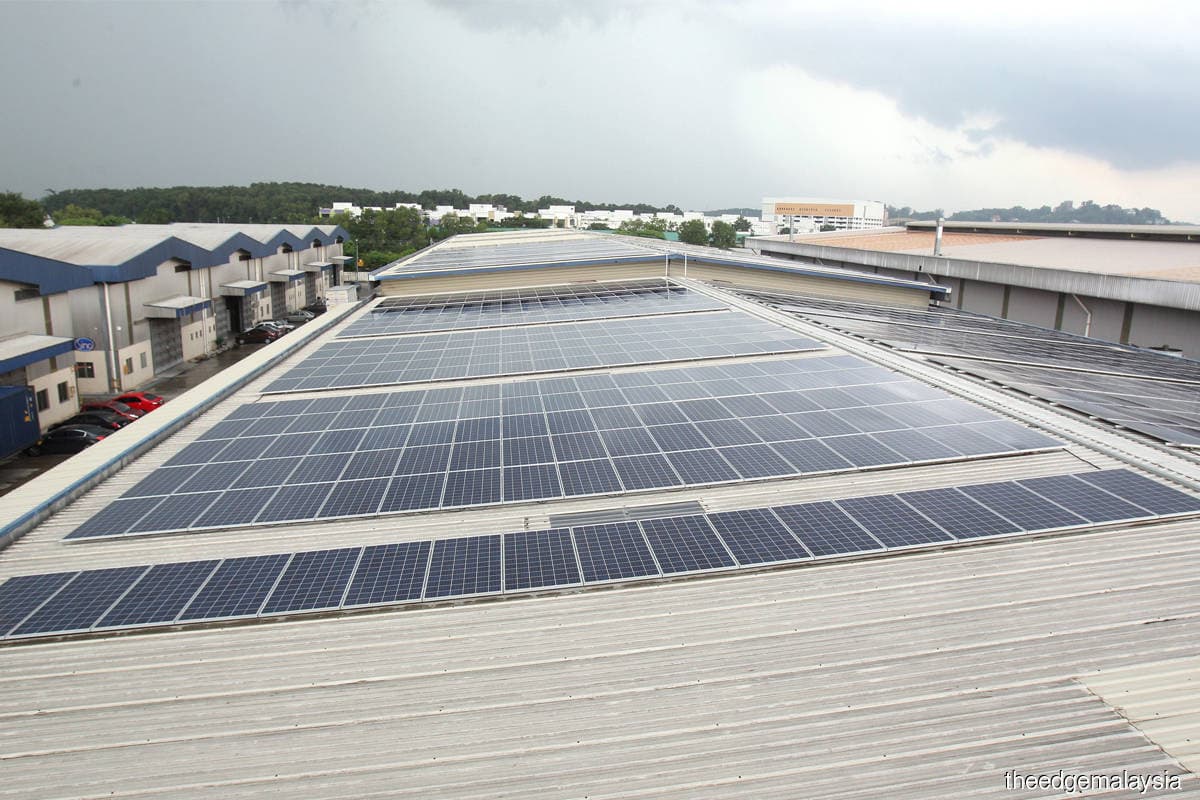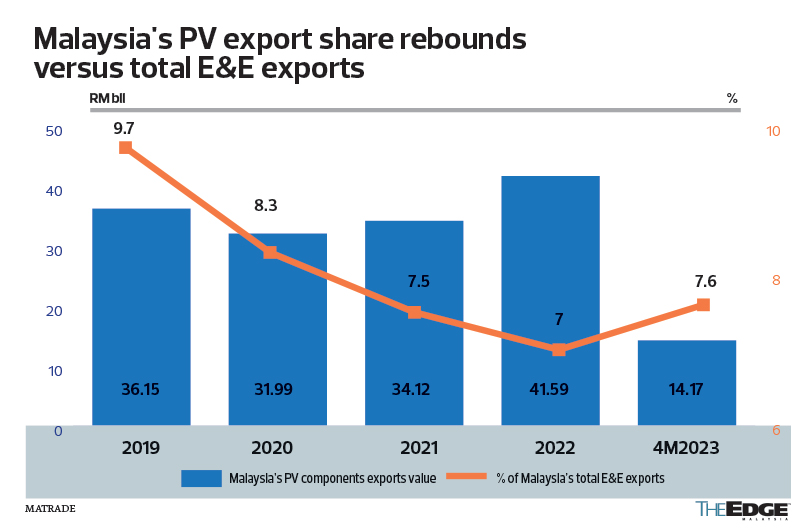
This article first appeared in The Edge Malaysia Weekly on May 29, 2023 - June 4, 2023
ONCE again, Sino-US tensions have put Malaysia’s solar photovoltaic (PV) module manufacturing industry in the countries’ crosshairs, amid US threats of sanctions against companies that use materials sourced from China.
Lawmakers in the US, where an estimated 20gw of PV capacity was installed last year, had attempted to reinstate tariffs on PV modules from Malaysia, Vietnam, Cambodia and Thailand. Fortunately, the move was vetoed by US President Joe Biden this month, keeping an existing waiver on tariffs for another year until June 2024 and buying Malaysia a little more time.
Having said that, despite US tariffs being imposed on Malaysia from 2018 to 2022, the Malaysian PV industry, along with that of its three Asean peers, has managed to grow, owing to the strong demand for the product. Almost all of the PV products manufactured in Malaysia — largely PV cells and modules (cells that have been assembled) — are exported.
According to Malaysia External Trade Development Corp (Matrade), exports of Malaysian-made PV products in 2022 exceeded pre-pandemic levels, rising 22% year on year to RM41.6 billion, or 7% of the RM593.5 billion of electrical and electronics (E&E) exports last year.
In 2022, the six biggest export destinations were the US (22.9%), Singapore (13.1%), Hong Kong (13.1%), China (11%), Germany (9.9%) and Vietnam (7.3%).
Malaysia also produced 50,000 tonnes of polysilicon — a key material for solar cells — representing 6.7% of the global supply of 750,000 tonnes, according to 2021 data by the International Energy Agency (IEA).
Unlike other E&E segments with local champions, however, solar PV manufacturers in Malaysia consist mainly — if not solely — of players from China and the US, highlighting the impact of the former’s dominance in the local industry.
Entrance and exit of local manufacturers
Today, the Kulim Hi-Tech Park houses manufacturing facilities for US-based First Solar Inc — which at one point was one of Malaysia’s top E&E multinational corporations by exports — and China-based Risen Energy Co Ltd.
Other China-backed players in the country include US-listed Maxeon Solar Technologies in Melaka and Shanghai-listed LONGi Green Energy Technology Co Ltd in Kuching and Jinko Solar Co Ltd in Penang. South Korea-based Hanwha Qcells operates in Cyberjaya. JA Solar Technology Co also operates in Penang, but channel checks show it temporarily suspended operations last year.
While Chinese companies expanded here to circumvent the trade restrictions imposed by the US government, American companies have built capacity to remain cost-competitive. These players took advantage of Malaysia’s workforce capabilities, built on the back of the country’s E&E growth over the years.
In the past, Malaysia’s PV manufacturing industry boasted the presence of local assemblers, as well as several other companies from the US, Japan and Europe. “When solar installation was first induced by the Malaysian government over 10 years ago under the Feed-in Tariff (FiT) mechanism, the high tariffs supported the setting-up of local manufacturers as pricing still made sense,” an industry player explains.
Local FiT projects were given tariffs of up to RM1.23/kWh in 2012, according to data by the Sustainable Energy Development Authority (SEDA). Also provided later were a sales tax exemption of 10% and an additional tariff of five sen/kWh on locally manufactured modules.
As the influx of Chinese panels pushed global prices lower in the subsequent years, FiT rates were adjusted to as low as 49 sen/kWh by 2015, and have slipped even lower since. This resulted in asset developers opting for cheaper alternatives.
“Even with the incentives for using locally manufactured panels, local manufacturers could not compete with Chinese products in the local market,” says the industry player.
Channel checks show that China-manufactured panels sold in Malaysia were priced about 23 US cents per watt at the time of writing, compared to about 30 US cents for Malaysian-made panels sold in the US before tariffs. In other words, the Malaysian-made panel is about 30% more expensive than the China-made product.
Progressture Solar, which builds solar assets for clients, concurs. “China manufacturers are doing it at such a scale that it allows them to drive their production cost lower and enables Malaysian solar players to benefit from the economies of scale,” its co-founder and chief operating officer Ng Yew Weng tells The Edge in an email reply.
To be sure, the China factor has hit not only local players but global manufacturers as well. In Malaysia, for instance, Japan’s Panasonic Corp was forced to shut down production in Kulim in 2021 amid price competition.
Earlier in 2019, US-based solar PV services outfit SunPower Corp spun off its manufacturing operations into Maxeon, which roped in China-based solar wafer producer Tianjin Zhonghuan Semiconductor Co Ltd as a substantial shareholder.
In 2018, Malaysian-listed Tek Seng Holdings Bhd suspended its PV manufacturing business after four years, although it stayed in the solar energy sales business. Prior to that, US-based SunEdison Inc shut down its Malaysian plant in 2016 as the parent filed for bankruptcy that year.
Previous US tariffs not entirely effective
At the end of last year, a preliminary investigation by the US Department of Commerce alleged that companies such as Longi and Canadian Solar Inc had circumvented existing tariffs on Chinese solar cells and panels.
Incidents of relabelling may have also occurred. Last week, First Solar brought a company to court in the US for relabelling First Solar’s Asian-made panels as “Made in the USA” when selling them in the market.
The US had imposed tariffs on China-made panels since 2012. Understandably, its tariffs on Malaysia from 2018 to 2022 contained certain exemptions, such as for products with technologies used by US-based First Solar.
Further, the tariffs were lowered by 5% each year, from 30% in 2018 to just 15% in 2022. On top of that, exemptions were given to 2.5gw worth of imported cells per year, and US imports did not hit the volume threshold until 2022.
According to data by the US Customs and Border Protection, import duties imposed by the US on Malaysian-made PV cells and modules are estimated at just US$1.67 million in 2019, US$2.18 million in 2020, US$1.22 million in 2021 and US$1.99 million in 2022. It had risen to US$2.53 million this year as at May 23.
As a result, companies continued to ramp up capacity in the region. In Malaysia, China-based Risen Energy set up its 3gw Malaysian factory — its first outside of China — only in 2021. Players benefited from investment incentives, including tax holidays, which, for example, last until 2026 for Maxeon and 2027 for First Solar.
On the flip side, the US tariffs succeeded in nudging some of the solar players in Malaysia to set up in the US. For instance, Jinko Solar has been operating a growing US plant since 2021, while JA Solar and Longi have expressed plans to manufacture in the US as well.
Impact of reimposition of US tariffs next year on local scene
Ahead of the potential US tariff reimposition in 2024, industry observers and players have mixed views on where the locally made panels — of which one-fifth is sold to the US — will end up or how the players will survive.
“This tariff issue is not new,” says Malaysian Photovoltaic Industry Association (MPIA) president Davis Chong.
Chong, who is also group CEO of Solarvest Holdings Bhd, thinks US asset owners will still continue to purchase Malaysian-made panels after the tariffs are imposed as demand is still very strong.
“If not, they can divert the supply to the region and other markets like Europe where demand is rising. The manufacturers here are ready.
“Malaysia’s market is too small to absorb the supply,” he says, referring to projections that Malaysia’s solar installed capacity would reach only 8.6gw in 2030, from about 2gw currently. By comparison, Malaysia’s annual module manufacturing capacity is estimated at 10.1gw.
Furthermore, the prices of panels that Malaysia imports from China are among the cheapest, if not the cheapest, he adds.
Samaiden Group Bhd CEO Chow Pui Hee points out that there were fire sales by manufacturers in Malaysia when the tariffs were initially imposed, and she does not discount a recurrence.
“Also, panels are bulky and an international shipment usually takes up to 20 containers or so. Some players may not mind paying a slight premium for local panels in exchange for better logistics costs and arrangements,” says Chow.
In any event, she adds, it will not be so easy for existing manufacturers to exit Malaysia, considering that it was not so long ago that many of them ploughed in more money to ramp up capacity.
“Owing to the price difference between China-manufactured panels and Malaysian-made ones, local users like us usually prefer to source panels from China, which are more affordable. But if the US tariff issue affects the export of Malaysian-made panels, and the panel makers here have to divert their sales to the local market, Samaiden is open to discussion to source our panels locally,” says Chow.
Progressture Solar says a local supply chain will help it “save 15% in import duties and shipping costs alone for solar panels”. “This is in addition to several other key components such as mounting structures and inverters where there is an additional reduction of 10%,” says Ng.
Indeed, the government is thinking of how to grow the industry along the solar PV value chain, although it has yet to present its plans. At a press conference last week, Natural Resources, Environment and Climate Change Minister Nik Nazmi Nik Ahmad pointed to Malaysia’s huge manufacturing capacity but made the observation that “it is a loss if they are all exported”.
It will not be easy for Malaysia to grow the industry and scale the value chain, though. Industry reliance on Chinese exports has increased, with the portion of China-made products climbing to 80% of the world’s PV value chain over the years, IEA data shows.
“How do you compete with China? The raw materials are there. Productivity is high,” says a local player. “When it comes to PV manufacturing, PV cells are where the [intellectual property] is. Module assembly is not very high-tech.”
With annual global capacity for solar PV manufacturing seen to exceed 400gw this year, it is a volume game for the product.
If Malaysia continues to support the growth of the industry, it will need to quickly leverage its partnerships and find a niche for itself — preferably higher up the value chain — as has been done in the wider E&E industry. Otherwise, it will continue to be a bit player.
Save by subscribing to us for your print and/or digital copy.
P/S: The Edge is also available on Apple's App Store and Android's Google Play.

